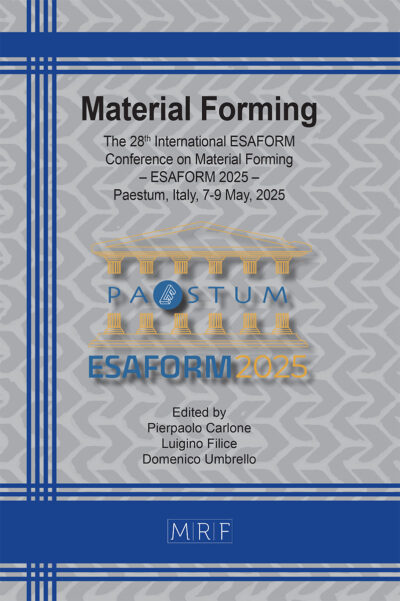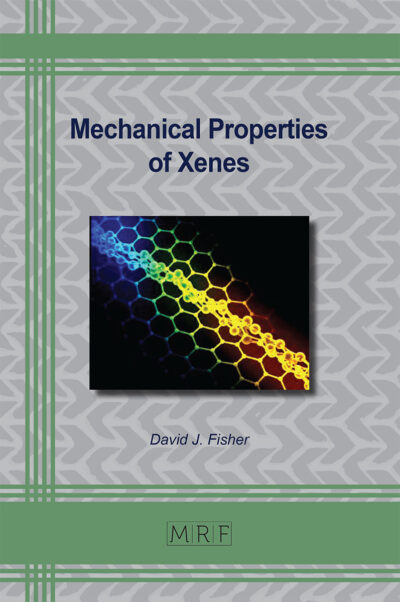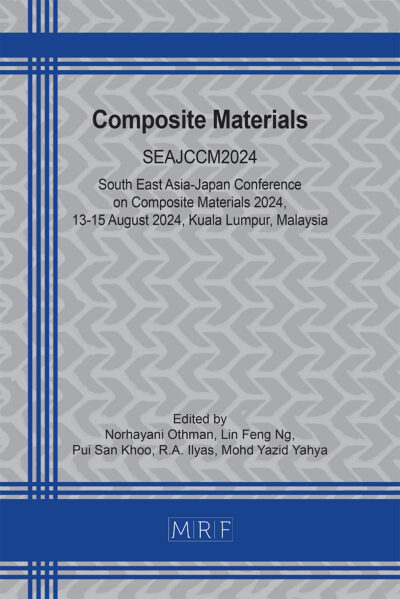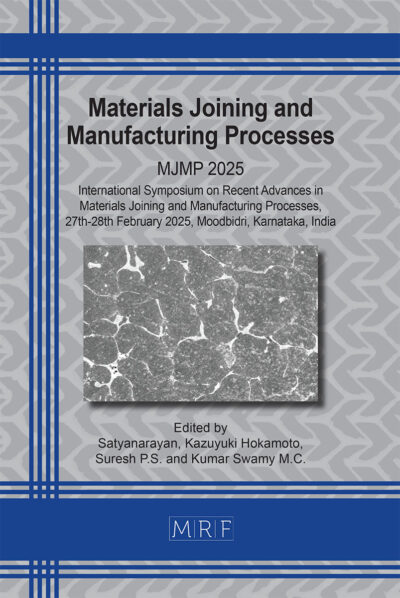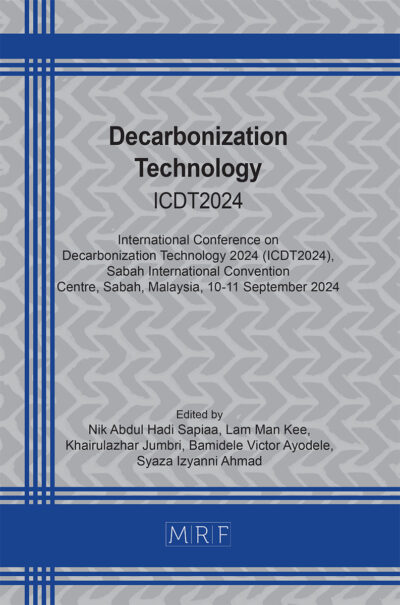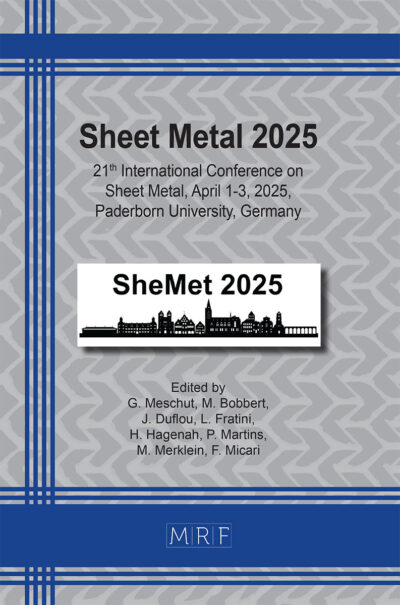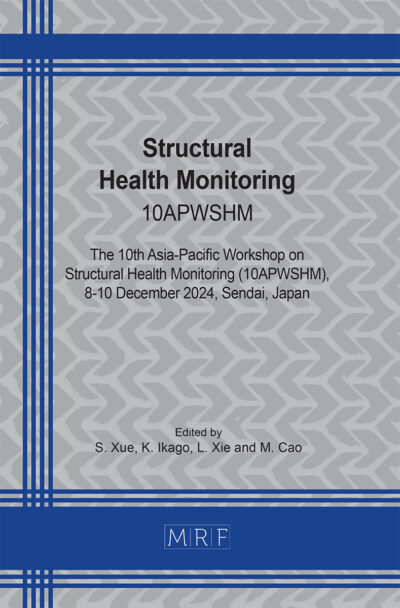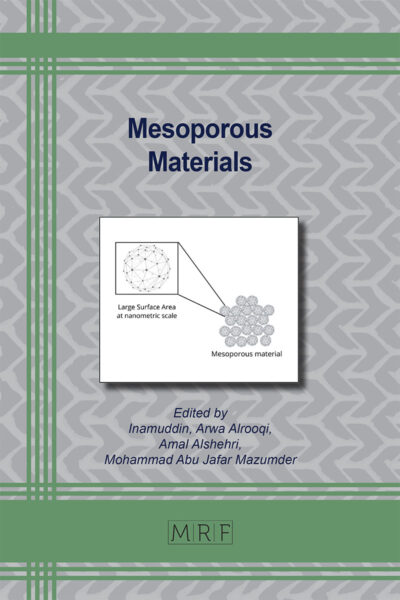Feasibility of 5-axis CNC friction stir welding of Aluminum 3003-H14
Austin CLARK, Ihab RAGAI, Gianluca BUFFA, Livan FRATINI
Abstract. This article investigates the effects various Friction Stir Welding (FSW) parameters have on the Ultimate Tensile Strength (UTS) of AA3003-H14 joints welded in a horizontal 5-axis CNC. The goal of this research is to combine the use of horizontal 5-axis machining with the ability to FSW in parallel. Two different tools were used in these tests. Both tools had tapered cylindrical pin profiles, while shoulder diameters were 19 mm and 25.4 mm, respectively. Along with the aforementioned tool shoulders, various tool rotation speeds and feed rates were evaluated with tensile tests conducted across 11 variable sets. A constant axial force of 5.2 kN was maintained during welding. A 25.4 mm tool shoulder was found to yield higher UTS than a 19 mm shoulder with the same feed rate and tool rotation speed. While feed rate had some effect on the strength of the weld, tool rotation speed did not have a significant effect on the tensile results in this study. The parameter set with the highest tensile strength in this test was performed with a 25.4 mm tool shoulder, tool rotation speed of 1200 rpm and a feed rate of 100 mm/min.
Keywords
FSW, 5-Axis CNC, Aluminum 3003, Process Parameters
Published online 5/7/2025, 10 pages
Copyright © 2025 by the author(s)
Published under license by Materials Research Forum LLC., Millersville PA, USA
Citation: Austin CLARK, Ihab RAGAI, Gianluca BUFFA, Livan FRATINI, Feasibility of 5-axis CNC friction stir welding of Aluminum 3003-H14, Materials Research Proceedings, Vol. 54, pp 1344-1353, 2025
DOI: https://doi.org/10.21741/9781644903599-146
The article was published as article 146 of the book Material Forming
![]() Content from this work may be used under the terms of the Creative Commons Attribution 3.0 license. Any further distribution of this work must maintain attribution to the author(s) and the title of the work, journal citation and DOI.
Content from this work may be used under the terms of the Creative Commons Attribution 3.0 license. Any further distribution of this work must maintain attribution to the author(s) and the title of the work, journal citation and DOI.
References
[1] Dixit, P., & Dixit, U. (2008). Modeling of Metal Forming and Machining Processes. Springer London. https://doi.org/10.1007/978-1-84800-189-3
[2] Vignesh, R. V., Padmanaban, R., & Govindaraju, M. (Eds.). (2023). Advances in Processing of Lightweight Metal Alloys and Composites: Microstructural Characterization and Property Correlation. Springer Nature Singapore.
https://doi.org/10.1007/978-981-19-7146-4
[3] Singh, B. R. (2012). A Hand Book on Friction Stir Welding. LAP Lambert Academic Publishing, UK. https://doi.org/10.13140/RG.2.1.5088.6244
[4] Kumar, A., Gautam, S. S., & Kumar, A. (2014). Heat Input & Joint Efficiency of Three Welding Processes TIG, MIG and FSW using AA606. International Journal of Mechanical Engineering and Robotics Research, 91-92.
[5] Takhakh, A. M., & Abdullah, A. M. (2011). An Experimental Investigation on Fatigue Properties of AA3003-H14 Aluminum alloy Friction Stir Welds. Journal of Engineering, 17(06), 1391–1401. https://doi.org/10.31026/j.eng.2011.06.07
[6] Mypati, O., Mishra, D., Sahu, S., Pal, S. K., & Srirangam, P. (2020). A Study on Electrical and Electrochemical Characteristics of Friction Stir Welded Lithium-Ion Battery Tabs for Electric Vehicles. Journal of Electronic Materials, 49(1), 72–87. https://doi.org/10.1007/s11664-019-07711-8
[7] European Aluminum Association. (2011). The Aluminum Automotive Manual.
[8] Dellal, N., Merzoug, M., Mimmi, A., Ghazi, A., & Lousdad, A. (2023). Experimental based determination and analysis of mechanical properties of AA 3003 alloy welded with friction stir lap welding process. Journal of Applied Engineering Science, 21(2), 451–461. https://doi.org/10.5937/jaes0-40245.
[9] Kelly, J. F., & Cotterell, M. G. (2002). Minimal lubrication machining of aluminium alloys. Journal of Materials Processing Technology, 120(1–3), 327–334. https://doi.org/10.1016/S0924-0136(01)01126-8.
[10] Santos, M. C., Machado, A. R., Sales, W. F., Barrozo, M. A. S., & Ezugwu, E. O. (2016). Machining of aluminum alloys: A review. The International Journal of Advanced Manufacturing Technology, 86(9–12), 3067–3080. https://doi.org/10.1007/s00170-016-8431-9.
[11] Mendes, N., Neto, P., Loureiro, A., & Moreira, A. P. (2016). Machines and control systems for friction stir welding: A review. Materials & Design, 90, 256–265. https://doi.org/10.1016/j.matdes.2015.10.124
[12] Ižol, P., Varga, J., Vrabel, M., Demko, M., Greš, M., (2022). Evaluation of 3-Axis and 5-Axis Milling Strategies when Machining Freeform Surface Features. Technical University of Košice, Faculty of Mechanical Engineering, Prototyping and Innovation Centre, Košice, Slovakia. Journal of Production Engineering, 25(1), 1–4. https://doi.org/10.24867/JPE-2022-01-001.
[13] Bologa, O., Breaz, R.-E., Racz, S.-G., & Crenganiş, M. (2016). Decision-making Tool for Moving from 3-axes to 5-axes CNC Machine-tool. Procedia Computer Science, 91, 184–192. https://doi.org/10.1016/j.procs.2016.07.056
[14] Meyghani, B., & Awang, M. (2022). The Influence of the Tool Tilt Angle on the Heat Generation and the Material Behavior in Friction Stir Welding (FSW). Metals, 12(11), 1837. https://doi.org/10.3390/met12111837.
[15] Davim, J. P. (Ed.). (2015). Modern Manufacturing Engineering. Springer International Publishing. https://doi.org/10.1007/978-3-319-20152-8.
[16] Wang, X., Xiao, Y., Shi, L., Zhai, M., Wu, C., & Chen, G. (2023). Revealing the mechanism of tool tilting on suppressing the formation of void defects in friction stir welding. Journal of Materials Research and Technology, 25, 38–54. https://doi.org/10.1016/j.jmrt.2023.05.184
[17] Thomas, W. M., Braithwaite, A. B. M., & John, R. (2001, September 27). SKEW-STIR™ TECHNOLOGY. 3rd International Symposium on Friction Stir, Kobe, Japan.
[18] Goyal, A., Punit Kumar Rohilla, & Atul Kumar Kaushik. (2017). Optimization of Friction Stir Welding Parameters for AA3003 Aluminum Alloy Joints Using Response Surface Methodology. Atul Kumar Kaushik, 12(1), 15–26. http://www.ripublication.com/ijms.htm
[19] Meyghani, B., Awang, M., & Wu, C. S. (2020). Finite element modeling of friction stir welding (FSW) on a complex curved plate. Journal of Advanced Joining Processes, 1, 100007. https://doi.org/10.1016/j.jajp.2020.100007
[20] Xiao, X., Mao, Y., Wang, X., Qin, D., & Fu, L. (2023). Effects of Curvature Direction on Friction Stir Welding Lap Joint of Aluminum Alloy “S” Curved Surface. In Review. https://doi.org/10.21203/rs.3.rs-2432943/v1
[21] Longhurst, W. R., Strauss, A. M., Cook, G. E., & Fleming, P. A. (2010). Torque control of friction stir welding for manufacturing and automation. The International Journal of Advanced Manufacturing Technology, 51(9–12), 905–913. https://doi.org/10.1007/s00170-010-2678-3.
[22] Chandu, K, Rao, A, & Subrahmanyam, B. (2014). The Strength of Friction Stir Welded Aluminum Alloy 6061. International Journal of Research in Mechanical Engineering & Technology, 119.
[23] Xu, A. (2020). Properties of Friction Stir Welded 3003-H17 Aluminum Alloy at High Travel Speeds. Journal of Physics: Conference Series, 1676(1), 012114. https://doi.org/10.1088/1742-6596/1676/1/012114
[24] Takhakh, D. A. M., & Abdullah, A. M. (2012). The Optimization Conditions of Friction Stir Welding (FSW) for Different Rotational and Weld speeds. Nahrain University, College of Engineering Journal, 15(2), 187–196.
[25] Kasman, Ş. (2022). Characterization of friction stir welded AA 3003-H24 aluminum alloy plates. Sigma Journal of Engineering and Natural Sciences – Sigma Mühendislik ve Fen Bilimleri Dergisi. https://doi.org/10.14744/sigma.2022.00066
[26] Shalin, M., & Hiten, M. (2018). Experimental Analysis on Effect of Tool Transverse Feed, Tool Rotational Speed and Tool Pin Profile Type on Weld Tensile Strength of Friction Stir Welded Joint of AA 6061. Materials Today: Proceedings, 5(1), 487–493. https://doi.org/10.1016/j.matpr.2017.11.109
[27] MatWeb. (2024). Aluminum 3003-H14. Retrieved from https://www.matweb.com/search/DataSheet.aspx?MatGUID=09c63ea8e10e4eea8398256801bb8514
[28] GROB-WERKE. (2023). G550T 5-axis universal mill-turn machining center. Retrieved from Grob: https://www.grobgroup.com/en/products/product-range/universal-machining-centers/mill-turn-machining-centers/g550t/
[29] Padmanaban, G., & Balasubramanian, V. (2009). Selection of FSW tool pin profile, shoulder diameter and material for joining AZ31B magnesium alloy – An experimental approach. Materials & Design, 30(7), 2647–2656. https://doi.org/10.1016/j.matdes.2008.10.021
[30] Elangovan, K., & Balasubramanian, V. (2008). Influences of tool pin profile and tool shoulder diameter on the formation of friction stir processing zone in AA6061 aluminium alloy. Materials & Design, 29(2), 362–373. https://doi.org/10.1016/j.matdes.2007.01.030.
[31] Arora, A., De, A., & DebRoy, T. (2011). Toward optimum friction stir welding tool shoulder diameter. Scripta Materialia, 64(1), 9–12. https://doi.org/10.1016/j.scriptamat.2010.08.052
[32] Ramanjaneyulu, K., Madhusudhan Reddy, G., & Venugopal Rao, A. (2014). Role of Tool Shoulder Diameter in Friction Stir Welding: An Analysis of the Temperature and Plastic Deformation of AA 2014 Aluminium Alloy. Transactions of the Indian Institute of Metals, 67(5), 769–780. https://doi.org/10.1007/s12666-014-0401-z
[33] Zwick Roell. (2024). Materials Testing Machines ProLine Z005 to Z100. Retrieved from https://www.zwickroell.com/fileadmin/content/Files/SharePoint/user_upload/PI_EN/02_375_ProLine_Z005_up_to_Z100_Materials_Testing_Machine_PI_EN.pdf
[34] Gao, K., Basak, S., Mondal, M., Zhang, S., Hong, S.-T., Boakye, S. Y., & Cho, H.-H. (2022). Friction stir welding of AA3003-clad AA6013 thin sheets: Microstructural changes related to tensile properties and fatigue failure mechanism. Journal of Materials Research and Technology, 17, 3221–3233. https://doi.org/10.1016/j.jmrt.2022.02.073
[35] Boopathi, S. (2017). Review on Effect of Process Parameters—Friction Stir Welding Process. 04(07).
[36] Abnar, B., Gashtiazar, S., & Javidani, M. (2023). Friction Stir Welding of Non-Heat Treatable Al Alloys: Challenges and Improvements Opportunities. Crystals, 13(4), 576. https://doi.org/10.3390/cryst13040576


